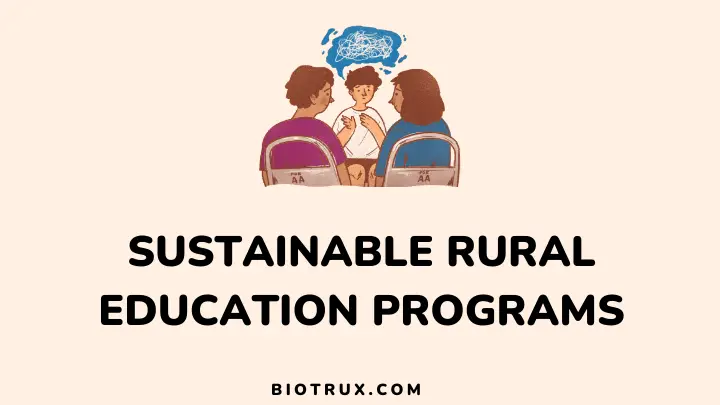Are you looking to make a difference in rural communities while improving education? Look no further than sustainable rural education programs. These innovative initiatives have taken root in communities worldwide, providing quality education and ensuring sustainability.
Not only do these programs support education, but they also strengthen the social and economic fabric of rural areas. Imagine schools powered by renewable energy sources and supported by sustainable farming practices.
These programs foster an environment of innovation and progress, to create a better future for all. In this article, you will explore sustainable rural education programs’ concepts, challenges, components, and success stories.
Join me as we learn more about this critical and exciting movement.
The Concept of Sustainable Rural Education Programs
Definition and purpose
Sustainable rural education programs are implemented to promote education in rural areas in an environmentally friendly manner. They aim to educate children in rural areas on sustainable practices that can help to improve their communities.
These programs are not only about providing access to education but also empowering these rural communities to take ownership of their sustainable development.
Objectives and goals
The objectives and goals of sustainable rural education programs are to:
- provide access to quality education in rural areas.
- promote sustainable practices that improve the quality of life for rural communities.
- empower these communities to take ownership of their sustainable development.
- increase economic opportunities in these communities.
- preserve cultural heritage in rural areas.
In summary, sustainable rural education programs have a lot of potential to positively impact the lives of those living in rural communities. It can improve their quality of life, preserve cultural heritage, and drive economic development.
The Current State of Rural Education

Educational disparities in rural areas
Many rural communities in various parts of the world continue to confront significant educational disparities. These communities often have limited access to quality education, which leads to lower literacy rates and reduced educational outcomes.
Cultural beliefs and heritage, transportation challenges, and the resistance to learning in these areas contribute to the educational disparities.
As a result, students in rural communities often need help to achieve academic success and face significant barriers to pursuing higher education or achieving a certain level of enlightenment.
Lack of infrastructure and resources
Many rural areas need help in providing a quality education to their students. One of the biggest obstacles is the lack of proper infrastructure and resources to support learning.
For example, many rural areas need better internet connectivity, making it difficult for students to access online learning materials or virtual classrooms. Additionally, school buildings in rural areas may need to be revised.
Some schools need more equipment, facilities, and technology to support modern teaching methods. Access to educational materials can also be limited, with many rural schools struggling to provide up-to-date textbooks, digital resources, and other learning aids.
These factors can contribute to a significant gap in educational opportunities between rural and urban areas.
Teacher shortages and quality of education
Rural areas often face difficulties attracting and retaining experienced and qualified teachers. This is due to various reasons, such as lack of resources, limited professional development opportunities, and lower salaries.
As a result, these communities often need more skilled educators. This consequently leads to lower-quality education and limited access to quality learning opportunities for students.
This issue has a significant impact on the overall development of rural communities. It highlights the need for comprehensive policies that address the root causes of the problem.
Components of Sustainable Rural Education Programs
- Infrastructure development: Building and maintaining appropriate infrastructure, such as classrooms, libraries, and sanitation facilities, is essential for sustainable rural education programs. This can improve access to education and create a conducive learning environment for students.
- Teacher training and support: Providing training and support for teachers can improve the quality of education in rural areas. This includes ongoing professional development, mentoring, and access to resources to enhance their teaching skills and effectiveness.
- Community engagement and ownership: Engaging with local communities and involving them in decision-making can help create a sense of ownership and investment in the education system. This can also help ensure that education programs are aligned with the needs and values of the community.
- Curriculum relevance: Developing a curriculum relevant to rural students’ needs and interests can improve engagement and motivation. This can include incorporating local knowledge and skills into the curriculum and providing practical, hands-on learning opportunities.
- Technology integration: Integrating technology into rural education programs can improve access to information and resources and enhance teaching and learning of sustainable practices. This can include providing access to computers, the internet, and other digital tools and training teachers and students on how to use them effectively.
Overcoming Challenges of Sustainable Rural Education Programs

1. Funding and resource mobilization
Sustainable rural education programs can overcome funding challenges by creating partnerships with organizations, businesses, and individuals who share their vision. They can also leverage crowdfunding platforms, apply for grants, and work with government agencies to secure funding.
Additionally, they can develop income-generating activities such as sustainable agriculture, eco-tourism, or handicrafts to generate revenue for education programs.
2. Cultural and social barriers
Overcoming cultural and social barriers in rural communities requires engaging with community leaders, parents, and teachers to understand their beliefs and values.
Education programs can incorporate local traditions and practices into their curriculum and involve community members in decision-making. This can help build trust and create a sense of ownership and investment in the education system.
3. Government and policy support
Sustainable rural education programs can advocate for policies that support their initiatives. This may include increased funding for rural education, incentives for teachers to work in rural areas, and investments in infrastructure and resources.
They can also engage in dialogue with government officials. This can help raise awareness of the challenges faced by rural communities and the potential of education to drive sustainable development.
Measuring the Impact of Sustainable Rural Education Programs
1. Educational outcomes
One way to measure the impact of sustainable rural education programs is to analyze educational outcomes, such as literacy rates, level of adoption of sustainable practices, and innovation and initiative.
This can be done by conducting surveys and assessments to evaluate the program’s effectiveness in improving educational outcomes in rural communities.
2. Socioeconomic development
Socioeconomic development is one of the most reliable ways to measure the effectiveness of sustainable rural education programs. The growth of local economies reduced unemployment rates, and increased living standards are some outcomes of sustainable education initiatives in rural areas.
Education programs generate economic and social changes in rural areas by enabling people to acquire skills. Such programs offer rural communities better opportunities, increasing social equality and stability.
The socioeconomic development metric captures the multiple effects of education interventions. This makes them an important way of promoting equitable growth and poverty reduction.
3. Community empowerment
Measuring the impact of sustainable rural education programs can also involve assessing the level of community empowerment. It can involve analyzing the level of community participation in decision-making processes and their involvement in sustainable development.
Evaluating community empowerment can determine whether the program successfully empowers rural communities to take charge of their development.
Some Success Stories of Sustainable Rural Education Programs
1. Teach for India
This program aims to bridge the gap in educational inequality by placing young professionals and graduates as full-time teachers in low-income schools.
It works to eliminate educational inequity in India by placing fellows in under-resourced schools in rural areas. The program has helped improve education quality in underserved areas and has impacted over 32,000 students across India.
2. Room to read
This program focuses on improving literacy and gender equality in education in low-income countries. It provides teacher training, books, and scholarships for girls to promote literacy and education in rural areas. So far, Room to Read has impacted over 16 million children in Asia and Africa.
3. Barefoot college
This program trains rural women to become solar engineers, health workers, and teachers. The program provides education and skills training to empower women to become community leaders.
Over 75,000 women have been trained through the Barefoot College program. These are just a few sustainable rural education programs that have significantly impacted.
Investing in education in rural areas can help break the cycle of poverty and empower individuals to lead better lives.
Future Prospects
Sustainable rural education programs are expected to revolutionize how education is imparted to children living in remote and rural areas. The future of such programs looks very bright and promising.
These programs are expected to increase enrollment rates improved educational infrastructure, and employment opportunities for rural residents. Sustainable rural education programs will ensure that children in remote areas access quality education, thus improving their chances of having a bright future.
With such programs, we can ensure that no child is left behind and that every child gets a fair chance at education and, ultimately, a successful life.
FAQs
Are sustainable rural education programs effective?
Yes. These programs have shown remarkable results in empowering rural communities by providing access to quality education.
How can you support sustainable rural education programs?
You can support these programs by donating to organizations working in rural education and volunteering your time and skills. Another way is by advocating for better educational policies in rural areas.
What are the main challenges of sustainable rural education?
Challenges include limited access to technology, difficulty recruiting educators, and the need to tailor curricula to local needs.
Can sustainable rural education lead to economic growth?
Yes. These programs empower individuals to contribute to economic growth and self-sufficiency by providing education and skills.
How can you start a sustainable rural education initiative?
Starting an initiative involves identifying local needs, securing resources, and collaborating with educational organizations.
Final Thoughts
The significance of sustainable rural education programs can never be overstated. We need these programs now more than ever, not just for the students but for the future of rural communities and our planet.
Access to quality education is a fundamental right; rural students should not be denied this. It is time we prioritize sustainable rural education programs and ensure they receive the necessary funding and resources they deserve.
By investing in these programs, we are not only investing in the future of these communities but in the future of our planet. Planet. So, let us come together and advocate for sustainable rural education initiatives.
Let’s ensure every student has the opportunity to succeed and make a difference in their community.
You can also learn more about sustainable rural community engagement.
Thanks for reading.

